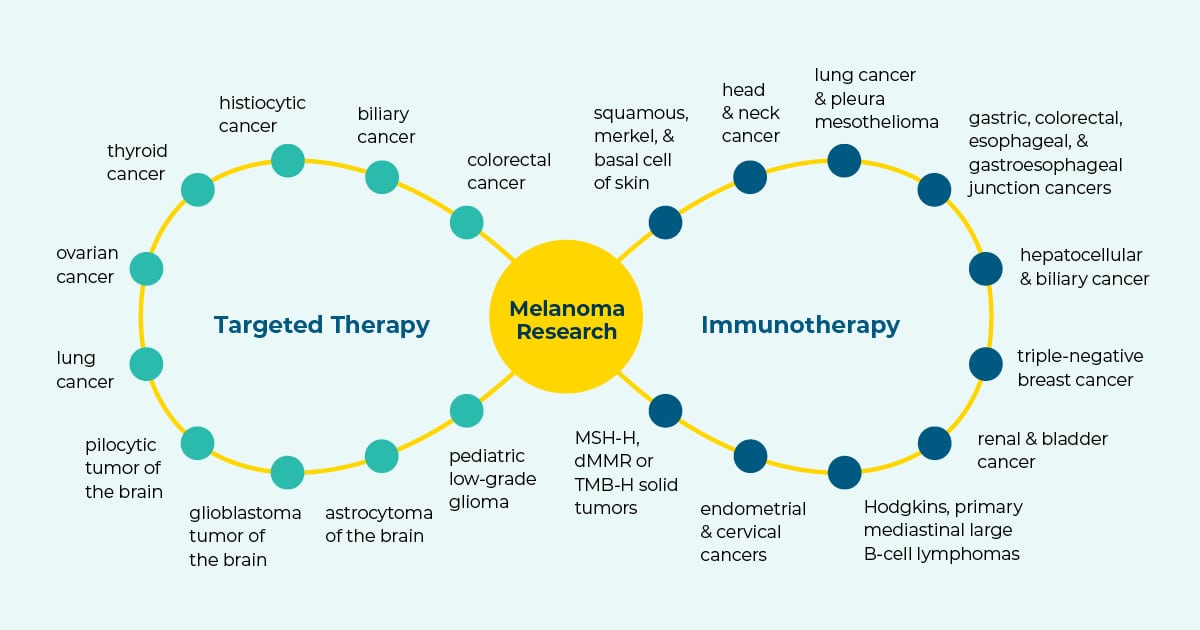News & Press
A Year of Progress and Hope
As 2023 comes to a close, we’d like to reflect on some of the major advancements in the treatment of cutaneous and metastatic uveal melanoma— bringing hope to many patients and their loved ones. The MRF’s mission is to eradicate melanoma by accelerating medical RESEARCH while EDUCATING to and ADVOCATING for the melanoma community and we are pleased to share a few highlights from this year.
Research
In June at the American Society of Clinical Oncology Annual Meeting, an update on the phase 3, KEYNOTE-716 study showed continued improvements of adjuvant pembrolizumab vs. placebo in completely resected, stage IIB/C melanoma patients, even at 3 years. Similarly, an update on the phase 3, RELATIVITY-047 trial reported continued benefit of combined PD-1 checkpoint plus LAG3 inhibitors vs. a PD-1 checkpoint inhibitor alone in previously untreated metastatic or unresectable melanoma after 2 years.
In July, Moderna and Merck announced the launch of a phase 3 trial of their personalized vaccine against melanoma, mRNA-4157 (also known as V940), plus pembrolizumab (Keytruda), as combination therapy for high-risk patients who have undergone surgery (which will build upon their encouraging phase 2 trial results previously reported). The phase 3 trial aims to enroll 1,089 patients, all at stages IIb to IV, with a primary endpoint of post-surgical recurrence-free survival. Final results are due in 2029. This fall, the MRF partnered with Dr. Jeffrey Weber, to produce a webinar for patients that explains the vaccine and how it works.
In August, the Food and Drug Administration approved HEPZATO KIT (melphalan for Injection/Hepatic Delivery System) containing melphalan (HEPZATO), as a liver-directed treatment for adult patients with metastatic uveal melanoma and unresectable hepatic metastases affecting less than 50% of the liver and no extrahepatic disease, or extrahepatic disease limited to the bone, lymph nodes, subcutaneous tissues, or lung that is amenable to resection or radiation. The MRF hosted a webinar with experts Dr. Marlana Orloff and Dr. Jonathan Zager to educate melanoma patients on this new approval.
In October at the Congress of the European Society for Medical Oncology (ESMO), correlative analyses from tissues collected on the S1801 trial were presented. The S1801 trial previously showed that immunotherapy administered both pre- and post-surgery had a longer event-free survival than post-surgery immunotherapy alone in patients with operable stage IIIB or stage IV melanoma. At ESMO, the investigative team reported that half of the patients that received pre- and post-surgery immunotherapy also had a major pathological response. This early promising phase 2 data will need to be built upon in the future.
In November, the final 2-year overall survival update was presented at the Society for Melanoma Research meeting on the DREAMseq trial. This trial sought to determine the optimal treatment sequence between combination checkpoint inhibitor immunotherapy and combination molecularly targeted therapy for patients with treatment-naive BRAFV600-mutant metastatic melanoma. “The DREAMseq trial established definitively that for most patients with metastatic BRAF mutant melanoma, the optimal treatment sequence involves combination immunotherapy followed by, if necessary, BRAF targeted therapy as opposed to the converse sequence” says Dr. Michael Atkins, MRF Scientific Advisory Committee, Co-Chair.
Education
Throughout the year, the MRF has distributed over 44,000 of free educational literature to educate and empower the community from prevention to those diagnosed with the disease. In December, the MRF released a new animated melanoma patient video on clinical trials featuring Dr. Michael Atkins and Dr. Sapna Patel. This animation explains what clinical trials are, how they are conducted, and why they are important for patients with melanoma. In this animation, we focus on trials of new melanoma treatments. This animation also provides an overview of the potential benefits and risks of participation, phases of clinical trials, eligibility criteria, informed consent, and more. Clinical trials can be a hopeful option for many patients, at any stage of melanoma – not just advanced disease. Be sure to discuss all your treatment options, including clinical trials, with your healthcare team.
Advocacy
Sunscreen remains one of the most important tools we have as melanoma advocates to prevent melanoma and other skin cancers, but for the past two decades, the Food and Drug Administration (FDA) has made few advances in bringing advanced and more protective sunscreen filters to market in the United States. On December 7th, the MRF’s Director of Advocacy, Kim Watkins, joined policy specialists and dermatologists in a briefing to congressional staffers to discuss pathways to improve sun safety measures, promote sunscreen protection and close the gap with global UV protection standards to reduce the rise of skin cancer incidence in the United States. Read more here.


